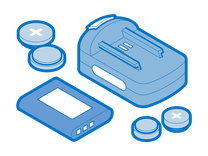Introduction
Is your Dell Latitude battery draining fast? This will go over several common occurrences when it comes to your Dell Latitude battery draining fast. The problem can be caused by either software or hardware causes, so read on to determine the right solution for you!
First Steps
This may seem trivial but a restart of your computer is the first thing you should try. This tends to fix some innocuous issues.
- Press and hold the power button for 10 to 15 seconds. If your laptop was powered on but not displaying anything, this will force restart it.
Bad Power Source. Some laptop chargers light up when you plug them into power (an LED is usually on the power brick or around the tip of the connector).
- Checking the wall port’s power by plugging in another device, light, etc. is a good idea. This lets you know the wall port is in fact providing power and that your laptop should be receiving a charge.
Causes
Are you charging devices from your laptop? Are you powering devices like an external webcam, keyboard, speaker, etc?
- Try using your laptop without any external accessories plugged in to establish a baseline power usage. This lets you know how much battery life you can expect out of normal use.
Sometimes, multiple devices, accessories, and settings could be affecting the battery performance. Rule out variables to focus your efforts on the real issue.
Your laptop might be running too many programs and background services. Lower the amount of services and programs running at once.

- Open Task Manager by right-clicking on the Windows start menu.
- Select a program you wish to close and click End task in the bottom right.
- You can get more information by click More details. The Startup tab shows what programs start with the computer, usually in the background. Disable any unnecessary startup programs.
Your laptop’s software settings may be pulling too much power. Adjust these settings to be more energy conscious. Settings like screen brightness, sleep settings, and CPU usage are all things to tweak.

- There are general power plans available to pick from (Balanced, High performance, and Power saver). You can select one by opening Control Panel from the Start menu and navigating to Hardware and Sound > Power Options. Switching to the Power saver plan helps to reduce the overall power consumption. Of course, you can always manually adjust these settings once in the Power Options section of Control Panel.
- The Dell Command utility is also used to alter power settings. You'll need to search your Service Tag or Serial Number using Dell's website to find a download link for Dell Command.
Starting with Windows 10, battery saver mode that automatically adjusts several of these energy-mindful settings at once. These instructions are for Windows 11 but should be similar for Windows 10.
- Right-click the Start menu and choose Settings. From there, head to System > Power & battery > Battery saver. This is also available in the bottom right Quick Settings area.
Certain BIOS settings will have an affect on your laptop’s performance and energy consumption. The BIOS is software installed on a chip on the motherboard. This chip and its software initialize hardware related settings. This menu exists before the operating system, so you will need to boot into the BIOS before the operating system loads to change settings.
- Power off your laptop completely.
- Press the power and repeatedly press the F2 key. It will boot into the BIOS menu where you can adjust various power-related settings.
- When finished, save and restart. Your laptop will boot into your operating system.
Your laptop battery could be older and needs to be replaced. Check out Dell Latitude Series Batteries.

Find compatible replacement parts for your Dell Latitude. All parts and fix kits are backed by the iFixit Quality Guarantee.







